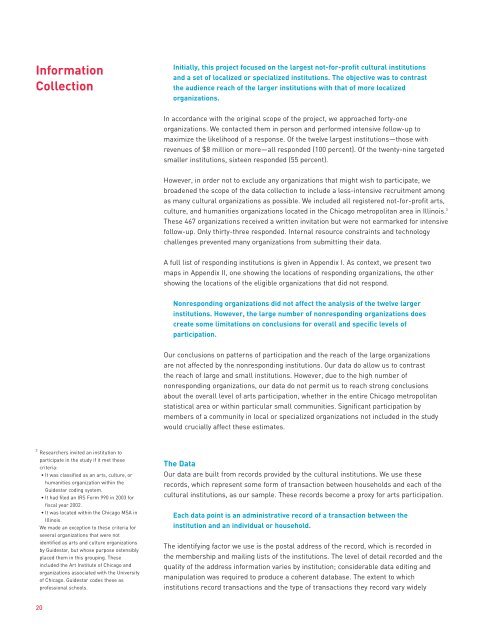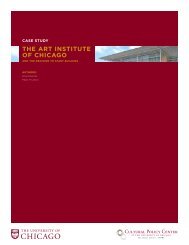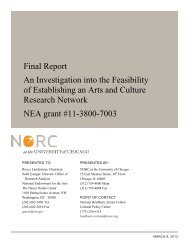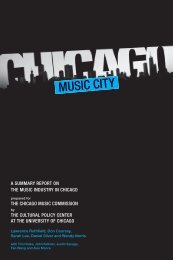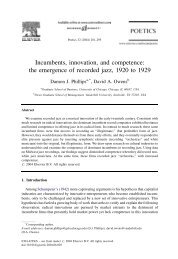Mapping Cultural Participation in Chicago - Cultural Policy Center
Mapping Cultural Participation in Chicago - Cultural Policy Center
Mapping Cultural Participation in Chicago - Cultural Policy Center
You also want an ePaper? Increase the reach of your titles
YUMPU automatically turns print PDFs into web optimized ePapers that Google loves.
InformationCollectionInitially, this project focused on the largest not-for-profit cultural <strong>in</strong>stitutionsand a set of localized or specialized <strong>in</strong>stitutions. The objective was to contrastthe audience reach of the larger <strong>in</strong>stitutions with that of more localizedorganizations.In accordance with the orig<strong>in</strong>al scope of the project, we approached forty-oneorganizations. We contacted them <strong>in</strong> person and performed <strong>in</strong>tensive follow-up tomaximize the likelihood of a response. Of the twelve largest <strong>in</strong>stitutions—those withrevenues of $8 million or more—all responded (100 percent). Of the twenty-n<strong>in</strong>e targetedsmaller <strong>in</strong>stitutions, sixteen responded (55 percent).However, <strong>in</strong> order not to exclude any organizations that might wish to participate, webroadened the scope of the data collection to <strong>in</strong>clude a less-<strong>in</strong>tensive recruitment amongas many cultural organizations as possible. We <strong>in</strong>cluded all registered not-for-profit arts,culture, and humanities organizations located <strong>in</strong> the <strong>Chicago</strong> metropolitan area <strong>in</strong> Ill<strong>in</strong>ois. 3These 467 organizations received a written <strong>in</strong>vitation but were not earmarked for <strong>in</strong>tensivefollow-up. Only thirty-three responded. Internal resource constra<strong>in</strong>ts and technologychallenges prevented many organizations from submitt<strong>in</strong>g their data.A full list of respond<strong>in</strong>g <strong>in</strong>stitutions is given <strong>in</strong> Appendix I. As context, we present twomaps <strong>in</strong> Appendix II, one show<strong>in</strong>g the locations of respond<strong>in</strong>g organizations, the othershow<strong>in</strong>g the locations of the eligible organizations that did not respond.Nonrespond<strong>in</strong>g organizations did not affect the analysis of the twelve larger<strong>in</strong>stitutions. However, the large number of nonrespond<strong>in</strong>g organizations doescreate some limitations on conclusions for overall and specific levels ofparticipation.Our conclusions on patterns of participation and the reach of the large organizationsare not affected by the nonrespond<strong>in</strong>g <strong>in</strong>stitutions. Our data do allow us to contrastthe reach of large and small <strong>in</strong>stitutions. However, due to the high number ofnonrespond<strong>in</strong>g organizations, our data do not permit us to reach strong conclusionsabout the overall level of arts participation, whether <strong>in</strong> the entire <strong>Chicago</strong> metropolitanstatistical area or with<strong>in</strong> particular small communities. Significant participation bymembers of a community <strong>in</strong> local or specialized organizations not <strong>in</strong>cluded <strong>in</strong> the studywould crucially affect these estimates.3 Researchers <strong>in</strong>vited an <strong>in</strong>stitution toparticipate <strong>in</strong> the study if it met thesecriteria:• It was classified as an arts, culture, orhumanities organization with<strong>in</strong> theGuidestar cod<strong>in</strong>g system.• It had filed an IRS Form 990 <strong>in</strong> 2003 forfiscal year 2002.• It was located with<strong>in</strong> the <strong>Chicago</strong> MSA <strong>in</strong>Ill<strong>in</strong>ois.We made an exception to these criteria forseveral organizations that were notidentified as arts and culture organizationsby Guidestar, but whose purpose ostensiblyplaced them <strong>in</strong> this group<strong>in</strong>g. These<strong>in</strong>cluded the Art Institute of <strong>Chicago</strong> andorganizations associated with the Universityof <strong>Chicago</strong>. Guidestar codes these asprofessional schools.The DataOur data are built from records provided by the cultural <strong>in</strong>stitutions. We use theserecords, which represent some form of transaction between households and each of thecultural <strong>in</strong>stitutions, as our sample. These records become a proxy for arts participation.Each data po<strong>in</strong>t is an adm<strong>in</strong>istrative record of a transaction between the<strong>in</strong>stitution and an <strong>in</strong>dividual or household.The identify<strong>in</strong>g factor we use is the postal address of the record, which is recorded <strong>in</strong>the membership and mail<strong>in</strong>g lists of the <strong>in</strong>stitutions. The level of detail recorded and thequality of the address <strong>in</strong>formation varies by <strong>in</strong>stitution; considerable data edit<strong>in</strong>g andmanipulation was required to produce a coherent database. The extent to which<strong>in</strong>stitutions record transactions and the type of transactions they record vary widely20


